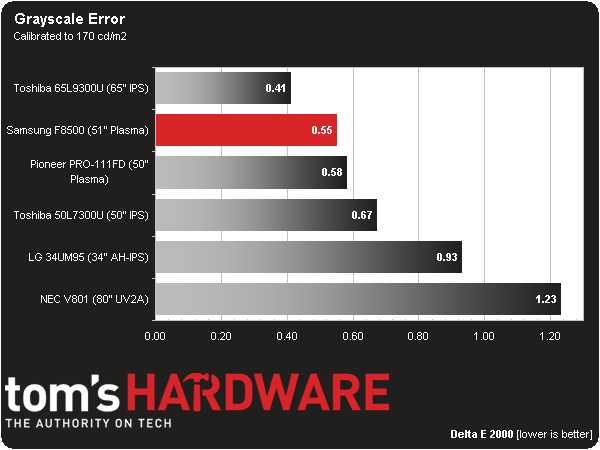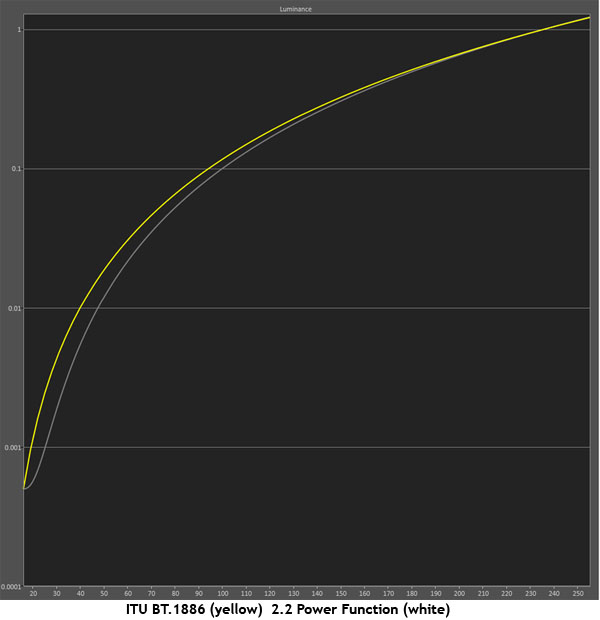Samsung PN51F8500 Review: A 51-Inch Plasma HDTV With SmartHub
Only two companies still make plasma TVs, so we’re excited to check out Samsung’s latest, the PN51F8500. It boasts 3D, SmartHub 2.0, and superb image quality. In the vast ocean of LCD televisions, it’s a compelling choice. Our lab results show you why.
Results: Grayscale Tracking and Gamma Response
It’s important that the color of white be consistently neutral at all light levels from darkest to brightest. Grayscale performance impacts color accuracy with regard to the secondary colors: cyan, magenta, and yellow. While you can manipulate them with tint control, dialing in grayscale often eliminates the need for further adjustment. Fortunately, a majority of monitors and HDTVs (especially newer models) display excellent grayscale tracking, even at stock settings.
First up is the result from the F8500’s Standard mode. This is the TV’s default setting.
We don’t need instruments to tell us how blue the image appears; we can see it plainly. By 100 percent, the error balloons to 12.69 Delta E. You can mitigate this by choosing a warmer color temperature preset or by simply choosing Movie mode, which we’ll show you next.
Samsung serves up a superb fire-and-forget image preset in the Movie mode. You don’t really need to calibrate to enjoy a very accurate picture. The brighter levels start to go a little blue, but the errors are only visible to our instruments. This represents an excellent performance.
After a single adjustment to the Blue Gain control, we record a superb final result. It’s as good as any high-end pro monitor we’ve measured lately. The F8500 is capable of near-perfect grayscale performance.
Here is the comparison group:
The lone computer monitor in our group achieves better grayscale performance out of the box. All of our HDTVs come set to a mode that offers plenty of brightness, but little in the way of accuracy. The image quality reflected in our chart is well-suited to a showroom, where dozens of screens compete for attention. But it's not a picture you’d want in your living room.
Get Tom's Hardware's best news and in-depth reviews, straight to your inbox.
If you only engage the F8500’s Movie mode, the grayscale average error becomes 1.09 Delta E. Calibration reduces that to .55, which places it in an elite group of professional monitors selling for far more per screen inch. We’re glad to see Samsung’s commitment to accuracy, even in an entertainment-oriented product.
Gamma Response
Gamma is the measurement of luminance levels at every step in the brightness range from 0 to 100 percent. It's important because poor gamma can either crush detail at various points or wash it out, making the entire picture appear flat and dull. Correct gamma produces a more three-dimensional image, with a greater sense of depth and realism. Meanwhile, incorrect gamma can negatively affect image quality, even in monitors with high contrast ratios.
We’re doing our gamma tests a little differently for HDTVs than computer monitors because, as of 2011, the standards are no longer the same. Computers use a power function with an average value of 2.2 for PCs and 2.0 for Macs. The new guideline for broadcast video is known as BT.1886, and it has an average value of 2.4 with a slightly different shape to the curve. Check out the sample graph below:
The goal is to improve shadow detail while maintaining similar output progression in the brighter levels. If you compare two images side by side, the difference is subtle. Your impression of depth shouldn't change. But darker material shows just a little more detail and clarity.
Our measurements for the F8500 reflect BT.1886, not the 2.2 power function.
You might be tempted to blame Dynamic Contrast for our result, but it's not the culprit. Rather, this is the Standard mode’s default gamma measurement. You can move the trace up and down the scale. That won't change its shape, though. The resulting image increases brightness at the expense of clarity and detail in highlights. The error at 90 percent is 29.5 cd/m2 too bright, representing a gamma value of .83.
Switching to Movie mode produces a near-perfect BT.1886 gamma trace. It was obviously Samsung’s intent to match the newer standard rather than the 2.2 power function seen on computer monitors and most other HDTVs. Hopefully competing television manufacturers follow suit.
The above graph shows the effect of Dynamic Contrast on its Low setting. Detail is crushed in both the darkest and lightest portions of the image. And since the F8500 already has tremendous dynamic range, it does nothing to improve quality. This test should convince you to leave Dynamic Contrast turned off.
Here is our comparison group again:
The other screens are measured against the 2.2 power function standard. But because we're expressing the amount of deviation, it’s a valid comparison. Samsung's F8500 achieves excellent gamma accuracy with its tight tracking of only .09. The numbers range from a low of 2.38 to a high of 2.48.
We calculate gamma deviation by expressing the difference from the standard as a percentage.
A 1.25-percent deviation is well below the point of visibility. As we saw in our grayscale results, the F8500 is as good as most of the highly-engineered professional panels we’ve tested.
Current page: Results: Grayscale Tracking and Gamma Response
Prev Page Results: Brightness and Contrast Next Page Results: Color Gamut and Performance
Christian Eberle is a Contributing Editor for Tom's Hardware US. He's a veteran reviewer of A/V equipment, specializing in monitors. Christian began his obsession with tech when he built his first PC in 1991, a 286 running DOS 3.0 at a blazing 12MHz. In 2006, he undertook training from the Imaging Science Foundation in video calibration and testing and thus started a passion for precise imaging that persists to this day. He is also a professional musician with a degree from the New England Conservatory as a classical bassoonist which he used to good effect as a performer with the West Point Army Band from 1987 to 2013. He enjoys watching movies and listening to high-end audio in his custom-built home theater and can be seen riding trails near his home on a race-ready ICE VTX recumbent trike. Christian enjoys the endless summer in Florida where he lives with his wife and Chihuahua and plays with orchestras around the state.
-
Nuckles_56 People still buy plasma screened TV's? I thought they went out like the floppy disk...Reply -
Merry_Blind Damn Samsung TVs have so much lag... They have amazing picture quality, but aren't fast enough for proper gaming... sigh... bring on the OLED!!!Reply -
n3cw4rr10r Am I the only one who thinks this is overpriced? especially with 4k TVs getting close to this range (Vizio P series will be out soon for $1000).Reply -
n3cw4rr10r Am I the only one who thinks this is overpriced? especially with 4k TVs getting close to this range (Vizio P series will be out soon for $1000).Reply -
colson79 It is such a shame everyone bailed on Plasma TV's, I still have one and the picture quality blows away LCD in the home theater. Hopefully my Plasma will last until OLED is reasonable. It would suck having to go to LCD.Reply -
jkhoward I love the quality of Plasma TV's.. I truly hope they keep developing this technology.Reply -
DisplayJunkie @Nuckles_56 your level of ignorance is astronomical yet not uncommon; you are making a fool of yourself.Reply
@n3cw4rr10r It's not overpriced at all, but rather an outstanding value (though not as good a value as the sorely-missed Panasonic P50ST60). The image quality is tremendously better than any 4K TV, even with perfect 4K source content, even if they sold the 4K TVs for $1500 or less. The difference in contrast(dynamic range) is the most important, and it is huge. Side-by-side with the plasma, no one would pick any 4K LCD. -
nthreem It's worth noting that Samsung announced it will discontinue production of plasmas at the end of the year. Better pick one up soon!Reply
I got a Panasonic VT60 at the beginning of the year, just as stock was running dry. I'm still amazed by the picture quality. -
Nintendo Maniac 64 ReplyHopefully my Plasma will last until OLED is reasonable.
Actually OLED is arguably already there or getting there. Some people were able to pick up LG's 55" OLED TV for $2000 (not a typo) via in-store at Microcenter.
For a more universal price-point, it's newest revision is now going for $3500. -
photonboy ReplyDamn Samsung TVs have so much lag... They have amazing picture quality, but aren't fast enough for proper gaming... sigh... bring on the OLED!!!
Most HDTV's have a "GAMING MODE" option which disables video processing inside the HDTV for a particular HDMI input such as your game console might use.
Having said that, burn-in issues have never been completely solved so I wouldn't game on a Plasma anyway (seems an important thing to mention doesn't it?).










